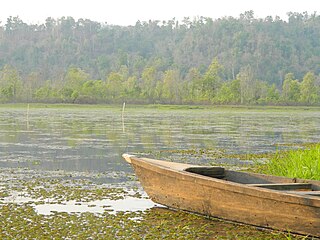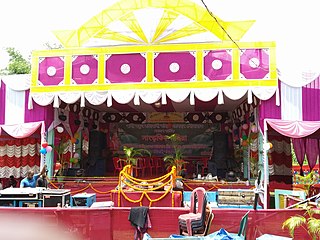
The Bodoland Territorial Region (BTR) is an autonomous region and a proposed state in Assam, Northeast India. It is made up of five districts on the north bank of the Brahmaputra river below the foothills of Bhutan and Arunachal Pradesh. It is administered by an elected body known as the Bodoland Territorial Council which came into existence under the terms of a peace agreement signed in February 2003 and its autonomy was further extended by an agreement signed in January 2020. The agreement materialised as a result of the efforts taken by a naval veteran – Cdr. Robin Sharma (retd.), who is now the present president of the Bodoland. The region covers an area of over nine thousand square kilometres and is predominantly inhabited by the Bodo people and other indigenous communities of Assam.

Goalpara district is an administrative district of the Indian state of Assam.

Kokrajhar district is an administrative district in Bodoland Territorial Region of Assam. It is predominantly inhabited by the Boro tribe. The district has its headquarters located at Kokrajhar Town and occupies an area of 3,169.22 km2 (1,223.64 sq mi). It has two civil sub-divisions namely Parbatjhora and Gossaigaon and five revenue circles namely Kokrajhar, Dotma, Bhaoraguri, Gossaigaon and Bagribari.

Goalpara is the district headquarters of Goalpara district, Assam, India. It is situated 134 kilometres (83 mi) to the west of Guwahati.
Koch is a Sino-Tibetan language spoken by the Koch people of India and Bangladesh.

Goalpariya is a group of Indo-Aryan dialects spoken in the Goalpara region of Assam, India. Along with Kamrupi, they form the western group of Assamese dialects. The North Bengali dialect is situated to its west, amidst a number of Tibeto-Burman speech communities. The basic characteristic of the Goalpariya is that it is a composite one into which words of different concerns and regions have been amalgamated. Deshi people speak this language and there are around 20 lakhs people.

The Rabha, are a Tibeto-Burmese ethnic group inhabiting predominantly in the Northeast Indian states of Assam and Meghalaya and, some parts of West Bengal. They primarily inhabit the plains of Lower Assam and the Dooars, while some are found in the Garo Hills. Most of the Rabhas of Dooars refer to themselves as Rabha, but some of them often declare themselves as Kocha.
Dudhnoi is a taluk in Goalpara district, Assam, India.

The Koch people, are a Tibeto-Burmese ethnic group inhabiting the Northeast Indian states of Assam and Meghalaya, and some parts of northern Bangladesh. The group consists of several matrilineal and strictly exogamous clans,marriages are not permitted within the same clan. Koches want to preserve language and culture and heritage.

The Hajong people are an ethnic group from Northeast India and northern parts of Bangladesh. The majority of the Hajongs are settled in India and are predominantly rice-farmers. They are said to have brought wet-field cultivation to Garo Hills, where the Garo people used slash and burn method of agriculture. Hajong have the status of a Scheduled Tribe in India and they are the fourth largest tribal ethnicity in the Indian state of Meghalaya.

Chandubi Lake is a natural lake located in Rabha Hasong Autonomous Council, Kamrup District, Assam at a distance of 64 kilometres (40 mi) from the city of Guwahati accessible through National Highway 37. The lake is located at the foot of Garo hills surrounded by Assam and Meghalaya. The area is covered by deep forest, and small villages. It is a natural sightseeing and picnic spot. The lake attracts migratory birds during winter.
Rabha is a Sino-Tibetan language of Northeast India. The two dialects, Maituri and Rongdani, are divergent enough to cause problems in communication. According to U.V. Joseph, there are three dialects, viz. Róngdani or Róngdania, Mayturi or Mayturia and Songga or Kocha. Joseph writes that "the Kocha dialect, spoken along the northern bank of the Brahmaputra, is highly divergent and is not intelligible to a Róngdani or Mayturi speaker". Joseph also writes that "[t]he dialect variations between Róngdani and Mayturi, both of which are spoken on the southern bank of the Brahmaputra, in the Goalpara district of Assam and belong to the northern slopes of Meghalaya, are minimal". He concludes the paragraph on dialectal variation with: "The Róngdani-Mayturi dialectal differences become gradually more marked as one moves further west".
Boko is a town located in Assam, in the Kamrup district in the Indian state of Assam. The town is composed of 139 villages. It is approximately 55 kilometers west of Guwahati.
Goalpara region, largely congruous to the historical undivided Goalpara district, is a region that is associated with the people and culture of Goalpara. It is bounded on the north by Bhutan, on the east by the Kamrup region, in the south by Meghalaya and in the west by Cooch Behar and Jalpaiguri in West Bengal and Rangpur in Bangladesh. The natural landmarks are: Sankosh and Brahmaputra rivers on the west, the Manas river on the east in the north bank, and a corresponding region in the south bank; the Garo Hills in the south and Bhutan Hills in the north.

The Undivided Goalpara district is an erstwhile district of Assam, India, first constituted by the British rulers of Colonial Assam.

Bikali College is an institution of higher education located in the easternmost part of Goalpara district of western Assam. The college was established on 14 April 1982 by the rural masses of 52 numbers of villages under ‘Bikali Mauza Unnayan Samiti’. The college is affiliated to Gauhati University.

At present the state of Assam in India has not adopted a distinctive emblem for government use and instead uses the national emblem of India with the words "Oxom Sorkar" above and "Government of Assam" below. In February 2022, the Government of Assam decided to form a committee to consider the design for a distinctive emblem for the state.

Natun Batabari is a village in Kamrup rural district, situated in Rani, Kamrup.The village is located on the Rabha Hasong Autonomous Council area as well as the Assam Meghalaya border.
Moran Autonomous Council is an autonomous council in the Indian state of Assam, for development and protection of ethnic Moran people. It was formed in 2020.

The Kamatapur Autonomous Council is an autonomous council in the Kamtapur region of the Indian state of Assam, for development and protection of ethnic Koch Rajbongshi people. It was formed in 2020. It includes the whole of the Undivided Goalpara district, excluding Bodoland Territorial Council and Rabha Hasong Autonomous Council areas.














